There is no more definitive way for a player’s legacy with his team to be cemented than to have his jersey number retired and raised to the rafters.
The Saskatoon Blades of the Western Hockey League (WHL) have bestowed that honour to six of their greatest alumni, having removed five jersey numbers from circulation in the process.
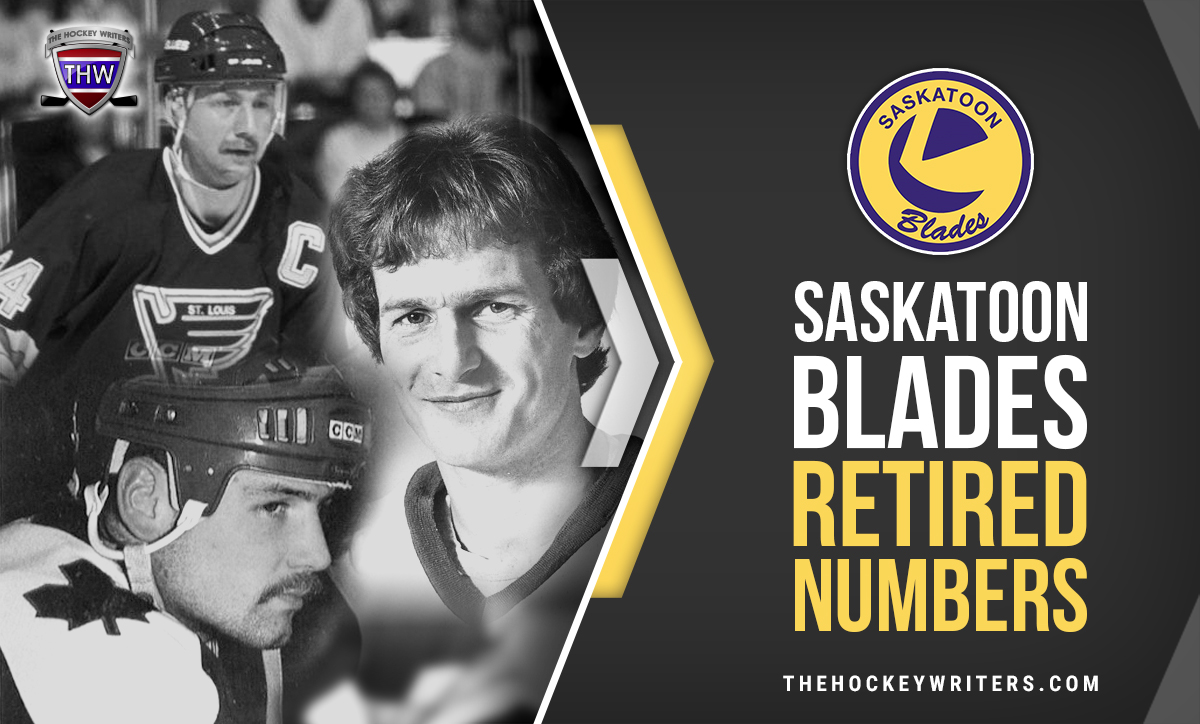
At the National Hockey League or professional levels, the criteria for doing this is usually fairly straightforward. Most commonly, it will be an acknowledgment of a player’s on-ice contributions and impact during their tenure with that team. The factors become more complex at the lower rungs, in this case, the WHL, where player development for the next level is equally relevant.
League-wide Retirements
Number retirement is almost exclusively a stick tap reserved for clubs to give to their own alumni. The NHL’s one exception is the league-wide retirement of No. 99 for Wayne Gretzky, which occurred in 2000.
Looking to another sport, Major League Baseball removed No. 42 from circulation across the sport in 1997 for Jackie Robinson, who broke the MLB’s colour barrier in 1947. New York Yankees’ closer Mariano Rivera was permitted to continue wearing the number until the end of his Hall of Fame career in 2013. Jackie Robinson Day was established in 2004, and after 2009, every player in the Major Leagues wears the number in honour of Robinson on April 15.
Related: The NHL’s Most Unbreakable Records
Also, while not a retirement, baseball has recently given players and coaches who are natives of Puerto Rico the option to wear No. 21 on Roberto Clemente Day, in commemoration of the late great Pittsburgh Pirates outfielder.
Gretzky has also been on record supporting the idea of retiring No. 9 for Gordie Howe.
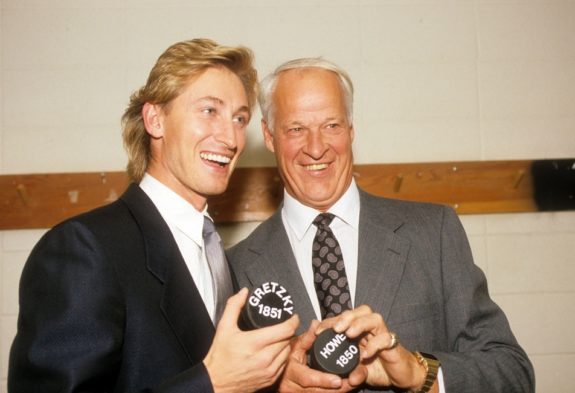
Howe was a native of Saskatoon, and after his death in 2016, the city declared Sept. 25, 2016 ‘Thank You, Mr. Hockey Day’. His ashes were interred inside the Gordie Howe statue outside of SaskTel Centre, followed by the Blades wearing special jerseys at their home opener for the 2016-17 season, which was attended by Hall of Fame broadcaster Bob Cole.
Finally, a bridge in the city was also renamed the Gordie Howe Bridge and the Blades partnered with Saskatoon Minor Hockey on establishing the Gordie Howe Player of the Year Award.
Junior Hockey, Big Legacies
Winning is the name of the game at every level, but in the development leagues like the three-member loops of the Canadian Hockey League, a player who goes on to excel in the NHL is every bit as much of a feather in the cap of his junior squad, and can be a prerequisite for jersey number retirement regardless of what he did during his time with his junior club.
A unique aspect of junior hockey is the link that teams and players have to their communities. Many junior hockey markets are smaller cities where fans look up to their own team and players the same as others would with the NHL, because there is a heightened sense of the players being their own.
Many players connect with their fan base in junior in ways that can only fully resonate with those who followed that team at that time.
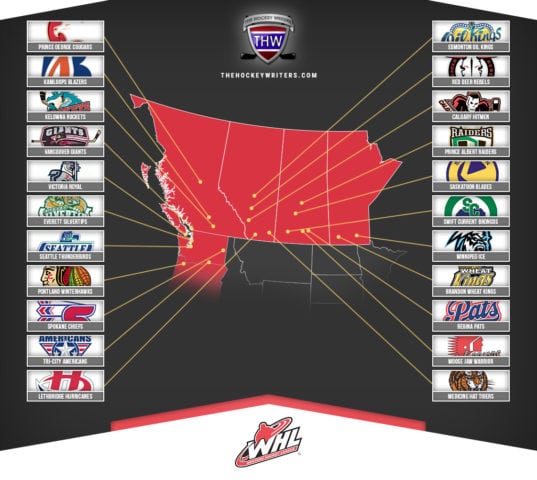
This can create instances where a player who did not make a widely recognized impact in the NHL, can become part of the lore of their junior club.
Blades Retired Numbers
No. 7: Brent Ashton & Gerry Pinder
A prime example of retiring a number for different reasons, the Blades have retired the No. 7 in honour of two players. In 2004, they enshrined 1978-79 team MVP and 1989 World Championship silver medalist Brent Ashton. In 2013, they bestowed the recognition on 1966-67 Canadian Major Junior Hockey League Player of the Year Gerry Pinder.
Ashton was a premiere scorer with the Blades for three-plus seasons (1975-79), registering 131 goals and 241 points in 173 games. During the WHL’s first season under its modern-day identity in 1978-79, Ashton set career-highs in goals (64) and points (119) in just 62 games.
The homegrown Saskatoon product proceeded to play 998 NHL games, registering 284 goals and 629 points for nine teams. He scored 20 goals in seven of his 14 NHL seasons, suiting up for nine teams.
Along with representing Canada at the World Championships in 1989, Ashton was also a Campbell Conference All-Star as a member of the Winnipeg Jets.
In addition to his Blades jersey number being retired, he was inducted into the Saskatoon Sports Hall of Fame in 2001, and then the Saskatchewan Sports Hall of Fame in 2007.
His son Carter played 54 games over three seasons with the Toronto Maple Leafs after playing four seasons in the WHL with three teams.
Gerry Pinder had two huge seasons with the Blades (1965-67) in the Saskatchewan Junior Hockey League and the CMJHL. Another hometown talent, Pinder struck for 78 goals and 140 points in just 55 games in his second season with the Blades
Pinder was the first Blade to hit the 40 through 70-goal and 90 through 100-point benchmarks in a single season.
The following season, Pinder won a bronze medal for Canada at the 1968 Olympics in Grenoble, France. The head coach of that team was Jack McLeod, who would become the Blades’ bench boss in 1970 and lead the team to sustained success over the next decade.
Pinder played two seasons for the Canadian National Team and went on to play three seasons in the NHL (1969-72), logging 55 goals and 124 points in 223 games for the Chicago Blackhawks and California Golden Seals. He capped off his career with six seasons in the WHA, skating in 353 games for three teams, including the Edmonton Oilers (1977-78).
No. 10: Brian Skrudland
Before he was a two-time Stanley Cup champion and the first captain of the Florida Panthers, Brian Skrudland wore the blue and gold of the Saskatoon Blades (1980-83) for three seasons.
In 208 games with Saskatoon, Skrudland racked up 77 goals and 192 points over 208 games. He was also part of one of the Blades’ greatest seasons in 1982-83, when he collected career-highs in goals (35) and points (94).
Skrudland was a rookie on the 1985-86 Cup champion Montreal Canadiens and won his second Cup as a veteran on the 1998-99 Dallas Stars near the end of his career. In total, he accumulated 124 goals and 343 points in 881 games across 15 NHL seasons.
After his playing days, Skrudland spent four seasons as an assistant coach in the NHL, first with the Calgary Flames (2000-03) and then the Panthers (2013-14). He also served two tenures as Florida’s Director of Player Development (2010-11, 2015-16).
No. 12: Bob Bourne
Before winning four consecutive Cups with the New York Islanders dynasty (1979-83), Bourne starred for three seasons with the Blades in the Western Canada Hockey League (1971-74).
The centerman from Kindersley, SK tallied 97 goals and 224 points in 192 career games with the Blades while playing with many iconic players from the Blades great WCHL era. He then jumped straight to the NHL and went on to play 14 seasons, with 258 goals and 582 points in 964 games. Bourne also registered 40 Stanley Cup playoff goals and 96 points across 139 games in 13 trips to the postseason.
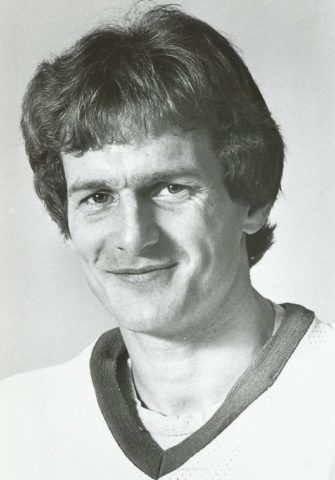
In Bourne’s final season in the NHL, he won the Bill Masterton Trophy as a member of the Los Angeles Kings.
The Blades retired Bourne’s jersey in 2005, and in 2017, he was inducted into the Saskatchewan Hockey Hall of Fame.
No. 15: Bernie Federko
The greatest NHL player the Blades have produced to date, Federko torched opposing goaltenders throughout his three seasons in Saskatoon (1973-76) before constructing an iconic career with the St. Louis Blues on his way to the Hockey Hall of Fame.
In total, the centre from Foam Lake, SK put up a staggering 133 goals and 344 points in 206 wearing the Pacman crest of the Blades. In his final season in the WCHL in 1975-76, Federko broke Bobby Clarke’s WCHL points record, finishing with a staggering 187, which included 72 goals.
Federko joined Bourne and Ashton on the Blades’ Team of the 1970s.
Upon his graduation from junior, Federko made his debut with the St. Louis Blues the next season in 1976-77 and went on to play 13 seasons for the team, serving as an alternate captain in his second to last season, and captain during his final campaign.
After finishing with the Detroit Red Wings, Federko played 1,000 NHL games in 14 seasons, counting 369 goals and 1,130 points. He went to the playoffs 11 times, scoring 35 goals and 101 points in 91 Stanley Cup playoff games, and led the NHL with 21 playoff points in 1985-86.
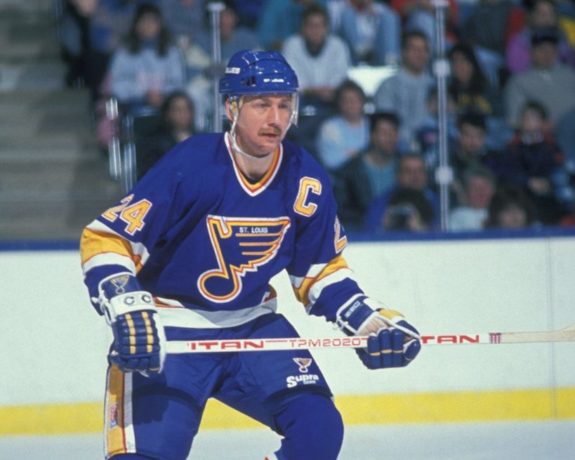
The Blues retired Federko’s No. 24 in 1991, followed by the Blades lifting his name and No. 15 to the rafters in 2002. He was inducted into the Hall of Fame that same year.
Federko has remained close to the Blues, working on the television broadcast crew of the team’s games as recently as this past season.
No. 22: Wendel Clark
One of the most popular Maple Leafs in modern times, Wendel Clark left his impact on the Blades as well, in his two seasons (1983-85) in the WHL.
Known for his scoring punch and toughness with the Maple Leafs, Clark’s grit was on display in Saskatoon, as evidenced by his 478 total penalty minutes, and he could certainly make an impact offensively, but he did so from the blue line while with the Blades. In 136 games, Clark netted 55 goals for 155 points. He posted WHL career-highs in goals (32) and points (87) in his second season in Saskatoon, while also scoring three goals and five points in seven games at the 1985 World Junior Championship, helping Canada win the gold medal.
Clark was a regular with the Maple Leafs the next season, named to the All-Rookie team and earned his first of two All-Star Game appearances. He was made an alternate captain the following season and wore a letter on his sweater for 11 of his 15 NHL seasons, including three seasons as captain in Toronto (1991-94).
Grit and toughness were hallmarks of Clark’s that can likely be attributed, at least in part, to his upbringing in Kelvington, SK. Three of Clark’s cousins who all grew up in Kelvington, had long professional hockey careers, and all were known to play an extremely physical game and drop the gloves.
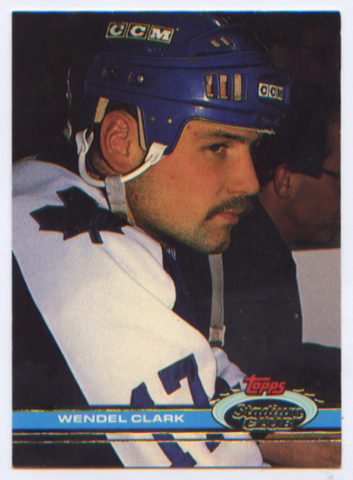
They included Barry Melrose and Joey Kocur, who both had lengthy NHL careers. The three-time Cup champion Kocur, also a Blades alum, eclipsed 2,500 career penalty minutes in 15 NHL seasons, and was the most penalized player in the league with 377 penalty minutes in 1985-86
The Blades retired Clark’s No. 17 in 2001, and his No. 17 was among the Maple Leafs’ greats to have their numbers retired before the team’s Centennial Anniversary home opener in 2016.
Legends In the Making
Part of the thrill of being a fan of a junior hockey team is letting your imagination ponder the possibility that you might be watching the next legend in the making develop before your own eyes.
Try as we might, there is no predicting when one of those players will come along.
Related: Top 10 Nicest Current NHL Jerseys
Could it be skillful center Kirby Dach, who blossomed into a star in Saskatoon and became the third overall pick of the Chicago Blackhawks? Can he cement himself as a centrepiece of the Blackhawks’ anticipated rebuild? Or might it be center Chase Wouters, who is due to become the longest-serving captain in Blades franchise history with the WHL aiming for a Jan. 8 puck drop for the 2020-21 season?
There are so many numbers that analyze hockey and sports today, but the greatest numbers are the ones that tell the enduring tales of the legends who have come before.